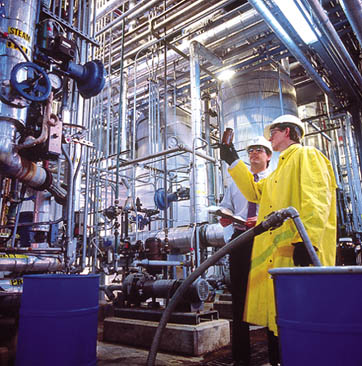Advantages of the UV/EB Curing Process and Recommended Safety Practices

UV/EB vs. Conventional Curing Methods
Ultraviolet light and electron-beam curable coatings are formulated with reactive monomers, oligomers, and additives to impart additional color, gloss, and leveling properties to the finished product. The reaction mechanism is free-radical polymerization, and is based on acrylates, methacrylates, vinyl and allyl compounds.UV curing is initiated by a photocatalyst, which absorbs distinct light energies, forming free radicals, and initiating polymerization. This free radical polymerization provides cured-in-place polymer networks.
Conventional curing methods depend on a predetermined chemistry based on a single polymeric backbone or a two-part system. The unsaturated carbon compounds in UV/EB curing may be changed in ratio quickly by each formulator. Novel cure-in-place polymers are uniquely developed.
Electron-beam curing does not require a catalyst for free radical initiation. Instead, electrons are excited and produce initiation of the acrylates, methacrylates, vinyls, and allyl chemistries incorporated into the formulations. Polymerization then continues as in UV free-radical curing methods. In UV/EB curing, low-viscosity reactive monomers provide application viscosity, adhesion, leveling, and physical properties. Conventional coatings depend on solvents such as toluene, methyl ethyl ketone, acetates or even water, which must be removed with hot forced air ovens or infrared heaters. This process allows the coating resin to dry or crosslink, forming a coating.
With UV/EB curing, the reactive monomers instantly crosslink, providing a cured, crosslinked coating that emits no VOCs and dries quickly.
Conventional coatings are based on isocyanates, epoxies or polymeric resins used in solventborne, high-solids or emulsion application systems; UV/EB cured coatings are based on similar backbone structures. Isocyanates and urethane pre-polymers are end-capped with hydroxyl acrylates and methacrylates. Epoxy resins are reacted with unsaturated acids to provide acrylate and methacrylate terminated oligomers. Polyesters and acrylic polymers are similarly terminated for free radical polymerizations. This reduces the health and safety hazards involved with the use of these chemicals as pre-polymers.
Reactive Monomers
Reactive monomers provide solvent-like properties and adjust viscosities for easy application. For example, monomer functionality, backbone structure, polarity, surface tension, viscosity and solubility provide adhesion, leveling, surface wetting, gloss, and reactivity.Safety Considerations
The molecular weights of reactive monomers are generally greater than 200, making the coating very low in volatility. In addition, low vapor pressure with flash points greater than 93ºC minimizes the risk of fire hazards. Thus, most monomers are classified as non-hazardous under the Department of Transportation regulations.Reactive monomers, like all chemicals, require standard safety and handling equipment, and require those who come in contact with them to practice standard chemical hygiene.
Impervious gloves and protective eyewear are normally required for monomer handling at room temperature. Acrylate, methacrylate, vinyl and allyl products used in coatings and ink formulations remain liquid, and will not dry, harden, or cure when left on lab tops, manufacturing equipment, or doorknobs. This liquid nature makes cleanliness imperative.
If materials come in contact with the skin, they should be removed with copious amounts of mild soap and lukewarm or cool water. Cool water will prevent the opening of skin pores, minimizing the surface area of contact and reducing the chemical contact time. Mild hand soap will prevent abrading the skin or rubbing chemicals into the skin’s pores during cleansing. A soap with aloe, vitamin E or other suitable skin oils helps prevent the skin from drying or cracking, further protecting the skin in the event of additional chemical contact. In addition to these safety measures, skin should be monitored for any reddening or chemical burns.
Even the best-kept areas in terms of cleanliness cannot prevent occasional equipment failures or spills from unsuspected sources. Thus, eyewear with protective side shields is a basic requirement in all chemical industries. If the eye is exposed to chemicals, flush with copious amounts of water and seek medical attention. Consult the manufacturer’s Material Safety Data Sheets (MSDS) for additional safety actions. In addition, it is always a good idea to have the MSDS accompany the person receiving medical attention.
Oligomers/Resins Urethane Acrylates
Urethane acrylates are among the most versatile backbones in the UV/EB field, because their molecular weights may be changed from only a few hundred to over 10,000. (Typical urethane acrylate molecular weights are 800–2,000).In conventional solventborne and two-component coatings, a urethane prepolymer made of a polyol end-capped with a diisocyanate is used. These same prepolymers may be temporarily terminated with reactive ingredients for emulsification, which will then volatilize and use the isocyanate reactive chemistry.
The urethane prepolymers in UV/EB curing are permanently end-capped with unsaturated hydroxyl chemistry, forming a non-volatile urethane. The unsaturated group, being an acrylate, methacrylate, vinyl, or allyl, is used for the free radical polymerization.
The amount of free isocyanate or free hydroxy unsaturation in urethane acrylates is typically undetectable. Isocyanates have considerable toxicological effects at low concentrations. The isocyanate-free urethane acrylates are low skin and eye irritants in comparison to their isocyanate terminated counterparts.
Safety Considerations
Urethane acrylates are generally viscous and require elevated temperatures or dilution with reactive monomers to reduce viscosity. All safety procedures should be based on the handling of urethane acrylates at elevated temperatures. There is little possibility of volatile free isocyanates due to the nature of urethane acrylate manufacturing. Protective gloves and eyewear are required with the handling of any chemicals to prevent exposure.
Epoxy-Based Oligomers/Resins
These chemicals are the largest volume class used in the UV/EB industries. A bisphenol-A-epoxy resin is reacted with acrylic acid or methacrylic acid to provide unsaturated terminal reactive groups. The versatility of the backbone structure provides a range of chemical coating properties. The epoxy-based oligomers may be viscous and have the same handling precautions as the heated urethane acrylates.
Safety Considerations
The oligomers and resins are diluted with reactive monomers to adjust the application and handling viscosities. Safety and handling precautions are generally based on the diluent. As always, impervious gloves and safety wear should be worn at all times. The acrylic acid/epoxy reaction to make bisphenol-A-diacrylate destroys any free ingredients such as epichlorohydrin used to make the bisphenol-A-epoxy starting raw material.
UV Equipment
UV-curing equipment consists of simple, single lamp curing units on fixed speed conveyors to units designed for two, four, eight, or more lamps with variable power sources for speed control and total input energy. This equipment basically provides artificial sunlight. Cylindrical or spherical vacuum bulbs generally contain a very small quantity of mercury, which is vaporized by an electrode passing current through the metallic vapor or by an instantaneous microwave energy source. The vaporized metal then emits light and infrared heat. The light energies are led in a single direction by use of elliptical or semi-circular, polished reflectors. The infrared energy is removed by high velocity air and/or water cooling of the reflectors.Safety Considerations
The ultraviolet light emits strongly in the UV “A” and UV “B” ranges, similar to the sun. Personnel working near or with UV equipment should wear UV-absorbing protective eyewear, because stray light may reflect off of the cured substrate. The manufacturing equipment itself helps protect personnel, being designed to prevent opening of the equipment while the light source is energized. In addition, it comes equipped with automatic shutdowns and cooling alarms.It is strongly recommended that personnel maintain skin moisture with the use of barrier/moisturizing creams and skin conditioning soaps.
Accidents, although rare, are quickly stopped by shutting off the lamps. Only the material under the lamps will be immediately damaged, and there will be no resulting explosions, fireballs, or large incinerations. The monomer’s flash point will not cause a fire, although the heat of combustion of the substrate or coating material may.
However, the only time heat becomes a safety issue during manufacturing is during a web break, when the material stays under the light system. The infrared energy and ultraviolet light energy may impart heat to the coating material, but the heat is generally very low, resulting in only a small rise in temperature. Heat from the chemical reaction is a further source of energy, elevating the temperature.
Electron beam safety concerns are minimal, as the additional radiation emitted during the process is completely shielded, so there is no operator exposure.
Summary
UV/EB curing technologies are rapidly growing fields, due to the many environmental and performance benefits for chemists, manufacturers, and consumers. For example, 100%-reactive ink, coatings and composites produce high-quality finished products for the consumer market. Faster drying times mean that manufactured items may be tested, packaged and shipped on the same day. In addition, the free radical curing equipment that initiates UV/EB curing is considerably smaller than traditional coatings manufacturing equipment.Most importantly, during UV/EB curing no environmentally destructive pollutants (VOCs) are emitted; nor is high energy required for the curing or drying of the inks and coatings. This exceptional technology enables the energy-efficient manufacturing of coatings, ink and adhesives, resulting in improved health and safety.
For more information on UV/EB curing, contact Sartomer Co., Oaklands Corporate Center, 502 Thomas Jones Way, Exton, PA 19341; phone 610/363.4100; fax 610/594.0252; visit www.sartomer.com.
Looking for a reprint of this article?
From high-res PDFs to custom plaques, order your copy today!





